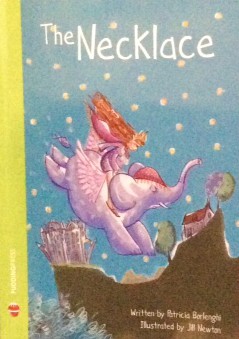Inspiring Young Readers
 posted on 31 May 2017
posted on 31 May 2017
The Necklace by Patricia Borlenghi, illustrated by Jill Newton
I am always on the look out for books with a character named Lucy as it is my daughter's name. This one, a slim early reader version of a Victorian fairy story, is published by the Pudding Press, an imprint of Patrician Press which describes itself as ' small, independent and courageous '.
The first thing to say is that the overall book design is very pleasing with a strong image of a fiercely determined looking princess riding on the back of an elephant with wings. All of this is set against a starry turquoise night sky and a landscape that includes a raging sea, and mountains in the distance. What a enticing image before even opening the book!
We learn that this is Princess Lucy 'who looked angelic but wasn't good at all'. She has a close friend, a witch called Willow with whom she practices magic and they have a pretty good time together. All this changes when her father decides that it is time for her to marry and Willow intervenes with some of her special magic. She gives Lucy a gold necklace which, if touched by anyone, will turn them into a bead. Sure enough every time a prospective bridegroom arrives, wedding preparations get under way and the magic happens. In this way Lucy gains some beautiful beads on her necklace 'each bead shiny, smooth and round. Each man submissive and silent'. First Prince Peter, then Prince Hector mysteriously disappear and they are followed by another eight.
By the time Prince Frederick decides to try his luck with marrying Princess Lucy, the King is lacking enthusiasm and his citizens are also fed up with all the royal wedding palaver, especially as they are now required to pay extra taxes to cover the costs. This Prince has a good friend Jasper who tries to put him off the idea as rumours about the disappearing princes are causing concern. It isn't until Jasper conspires with Lucy's servant Yolanda to find out more about the mystery, that they are able to put a stop to what is becoming a rather unpleasant habit.
After some devious shenanigans, Jasper outwits Lucy and the missing princes reappear. There is a happy ending , but not quite what you might expect. At least Lucy is not forced to marry against her will and gets to live
'frugally but contentedly' with her friend Willow, resolved to do no more black magic but instead 'dispensing animal- free beauty products and health remedies to mountain folk near and far.'
I liked this rather quirky story, well told with lively and colourful illustrations cut across both pages throughout the book. I understand that the original story was written by Mary de Morgan, a 19th century feminist and sister to William who worked with William Morris. The message in this modern version is loud and clear: girls shouldn't be told how to live their lives by men, something that still needs to be emphasised in the twenty first century.
Karen Argent
May 2017